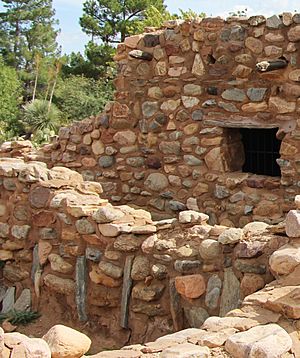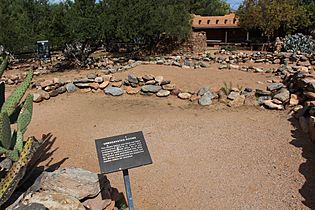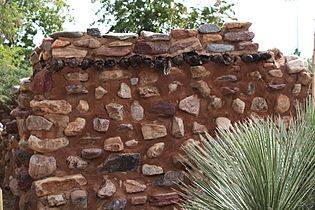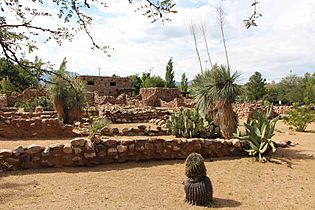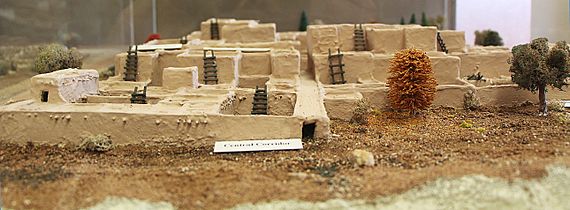Besh-Ba-Gowah facts for kids
Quick facts for kids |
|
|
Besh-Ba-Gowah
|
|
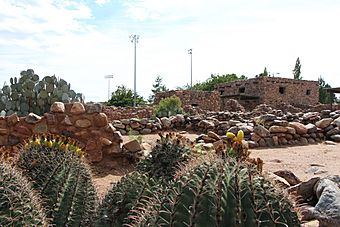
Besh-Ba-Gowah, Facing southeast towards central plaza
|
|
| Lua error in Module:Location_map at line 420: attempt to index field 'wikibase' (a nil value). | |
| Nearest city | Globe, Arizona |
|---|---|
| Area | 2.5 acres (1.0 ha) |
| NRHP reference No. | 84000648 |
| Added to NRHP | May 9, 1984 |
Besh-Ba-Gowah is an ancient village with 200 rooms built by the Salado people long ago. It sits on a ridge looking over Pinal Creek, about a mile southwest of Globe, Arizona. Today, it's a special place called the Besh Ba Gowah Archaeological Park and Museum. Here, you can see old pottery, stone tools, and woven items found during digs.
Contents
Discovering Besh-Ba-Gowah
Who Were the Salado People?
The Salado people lived at Besh-Ba-Gowah from about 1225 AD to 1400 AD. The term "Salado" describes a group of ancient people who lived in the Globe/Miami and Tonto Basin areas of Arizona. They lived there between 1150 AD and 1450 AD.
What Did the Village Look Like?
Besh-Ba-Gowah was a large village with many buildings. These buildings were made of stone and had multiple stories. They were grouped together, connected by long, narrow hallways or open areas. All these buildings were built around a big central plaza. This plaza was about 12 meters (40 feet) from north to south and 27 meters (89 feet) from east to west.
The walls at Besh-Ba-Gowah were built using granite stones and clay mortar. Inside, many rooms had walls covered with a smooth, white plaster. Some outside walls might have been plastered too. A cool feature of Salado buildings is that the bottom layer of stones in the walls often stood upright.
Why Is This Site Important?
The things found at Besh-Ba-Gowah have helped experts understand the Salado culture. Because of this, Besh-Ba-Gowah is known as one of the main "type sites" for the Salado culture. This means it's a key example that helps define what the Salado people were like.
History of the Site
Digging Up the Past
Excavations at Besh-Ba-Gowah began a long time ago. The work was funded by government programs like the Federal Emergency Relief Administration and the Works Projects Administration. These programs helped people find jobs during the Great Depression, a time when many people were out of work. This site is one of the few places in Arizona where ancient ruins were rebuilt and made stable during that time.
A Protected Landmark
Besh-Ba-Gowah was officially added to the National Register of Historic Places in 1984. This means it's recognized as an important historical place that should be protected.
Gallery


